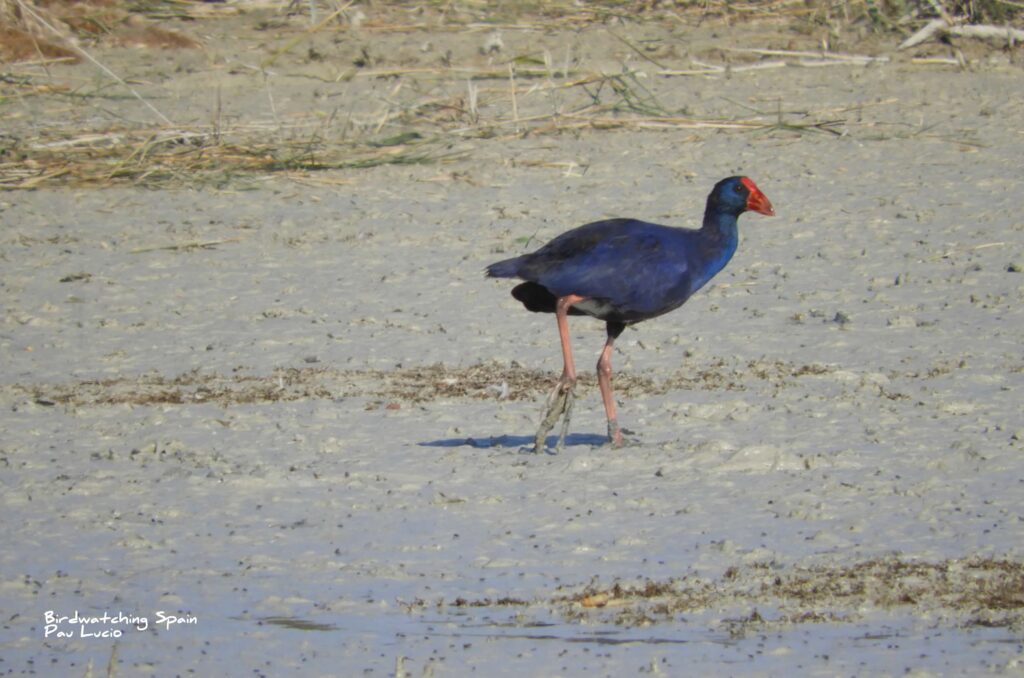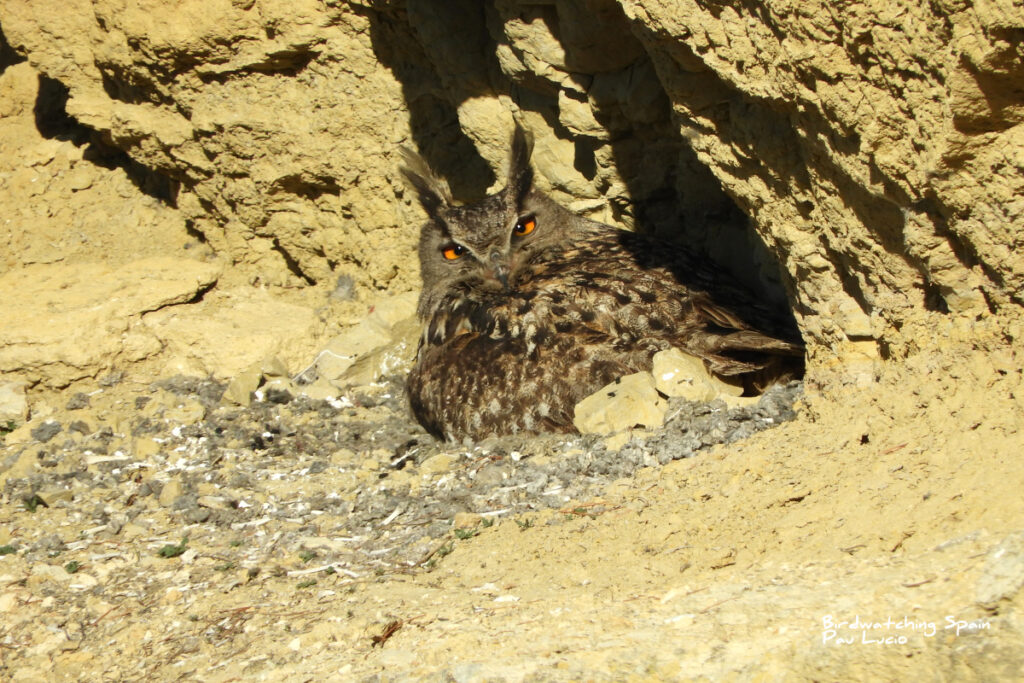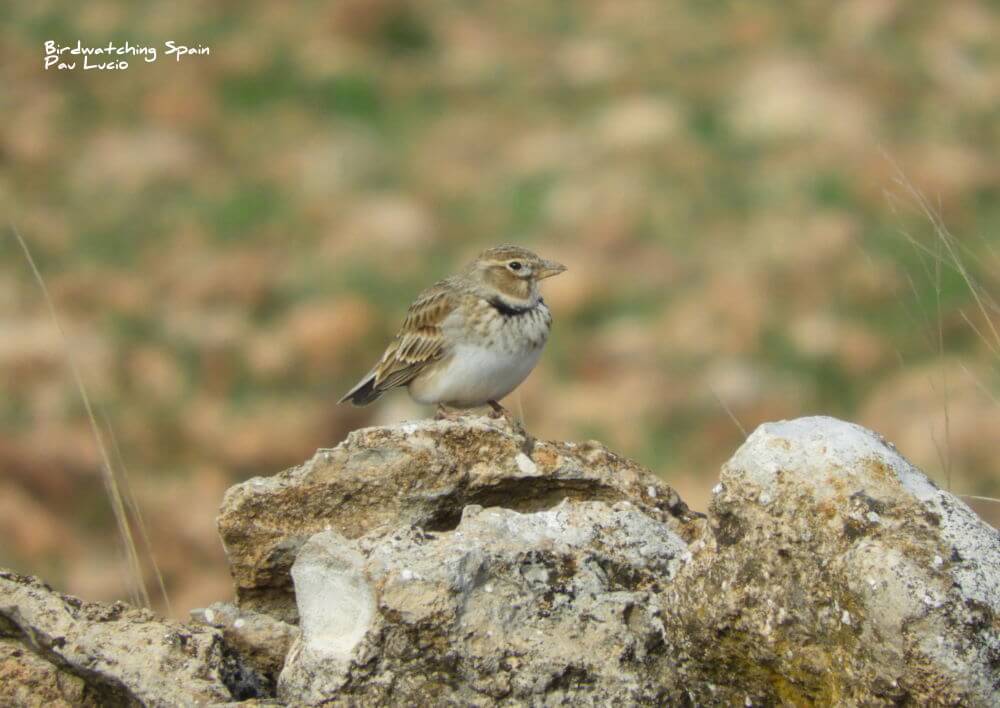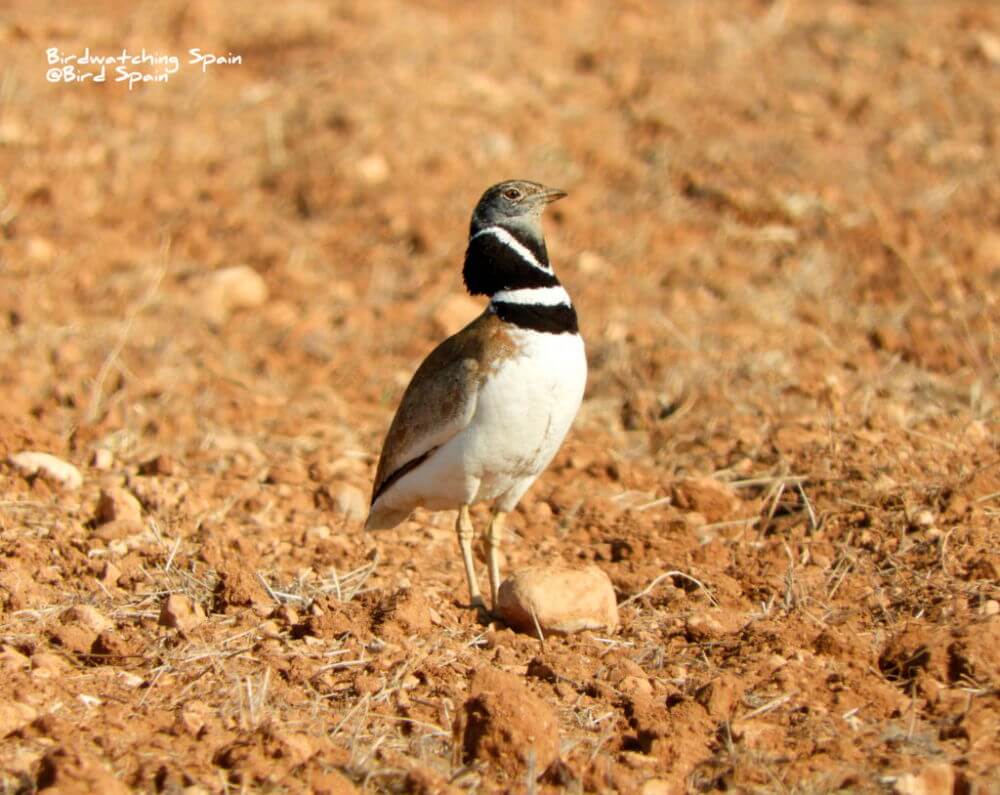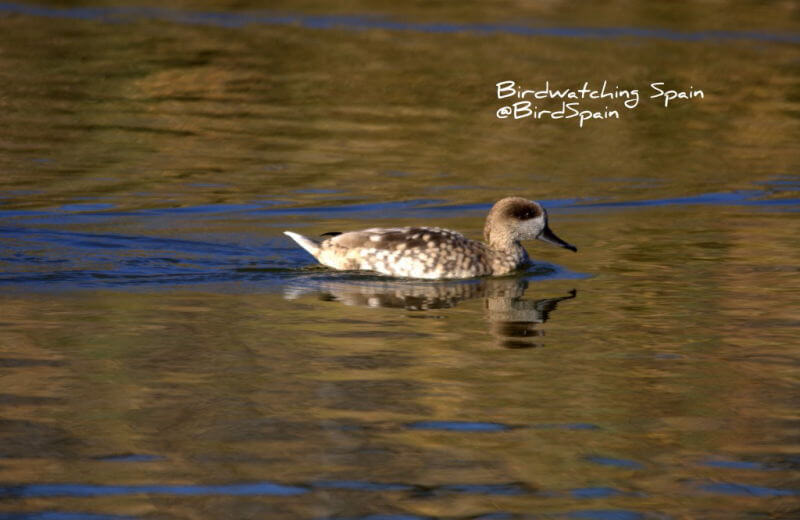Birdwatching and wildlife tours in Spain
Bird watching trip around Spain
13-DAY BIRD WATCHING TRIP AROUND SPAIN: From the Med to the Pyrenees with steppes in between
5 May – 17 May, 2015
This is a report of a 13-day bird watching trip in Spain that my wife Cherrie and I took with Pau Lucio, owner of the birding tour company “Birdwatching Spain.” Phillip, from Muncie, Indiana, joined us and made it a foursome.
Pau (pronounced “Pow”) timed the trip to be early enough to coincide with the later stages of spring migration and late enough to give us access to the high Pyrenees. We birded from May 5 through May 17. We also added a couple of days pre- and post-birding to enjoy some touristy sights in Valencia and Madrid.
It was especially nice that Pau, in addition to being an excellent birding guide, was an extremely knowledgeable naturalist. He pointed out a variety of butterflies, frogs, lizards, mammals, and flora. A major bonus for Cherrie was Pau’s help in tracking down and photographing several species of rare orchids.
ITINERARY (13-day bird watching trip around Spain)
Pau met Phillip at the train station in Valencia and the two of them then picked us up at our nearby hotel. We drove south approximately 40 miles to the small city of Gandia on the shores of the Mediterranean. Gandia is Pau’s home town and a major vacation destination for beachgoers later in the summer. We used Pau’s own vehicle, a Peugeot van/SUV that proved to be perfect. It was very roomy, accommodated our luggage, and was a good birding platform. The three of us clients rotated our seating every day.
Pau’s game plan was to use Gandia as a base of operations for the first five days. Each day we birded in a different area/habitat within an hour or two’s drive of Gandia. We then headed inland and north birding along the way through La Mancha until we reached the Pyrenees where we spent three days. We then turned south for Madrid and spent our final day birding in the foothills west of that city.
The birding itinerary on each day were as follow:
Day 1, Tuesday, 5 May – Travel to Gandia and check into our seaside hotel. We then birded the Gandia Marshes and two ravines in the Quatretonda area. Both sites were in the province of Valencia.
Day 2, Wednesday, 6 May – Natural Park Albufera de Valencia, in the province of Valencia. We birded Racó de l’Olla Visitor Center and Tancat de la Ratlla.
Day 3, Thursday, 7 May – Gandia Marshes (for Red-necked Nightjar), Pego Marshes in Valencia/Alicante Provinces, and Vall d’Ebo in Alicante Province.
Day 4, Friday, 8 May – Steppes of east Albacete, Albacete Province.
Day 5, Saturday, 9 May – Monnegre Gorge, Natural Park el Fondo and Salt Pans of Santa Pola, all in Alicante Province.
Day 6, Sunday, 10 May – Travel to La Mancha. Bird farmland around Belmonte in Cuenca Province. Bird lagoons of Alcázar de San Juan near Ciudad Real Province in Castilla la Mancha.
Day 7, Monday, 11 May – Natural Park Serranía de Cuenca in Castilla la Mancha region.
Day 8, Tuesday, 12 May – Serranía de Cuenca and Steppes of Belchite.
Day 9, Wednesday, 13 May – Travel from Belchite to the Pyrenees. Bird Belchite Steppes, Huesca area, and the Hecho Valley up to Selva de Oza.
Day 10, Thursday, 14 May – Parque Natural de los Valles Occidentales: Hecho, Ansó, Roncal.
Day 11, Friday, 15 May – Hecho Valley and then ski areas at Candanchú up to the French border, north of Jaca and Canfranc-Estación.
Day 12, Saturday, 16 May – Travel from Hecho to Madrid, birding in Huesca Province and in Natural Park Sierra de Guara for Tawny Pipit and Lammergeier.
Day 13, Sunday, 17 May – Sierra de Guadarrama, west of Madrid.
This itinerary, which stitched together some of Pau’s shorter birding forays, covered just over 2000 miles. We birded every inch of the way!
WEATHER
The weather was sunny and hot during the day and cool at night. Temperatures reached 34C on a few days, which was very unusual for mid-May. The Pyrenees cooled us off on the 14th and 15th. We encountered rain showers, and at higher elevations, sleet and then snow. Temperatures reached 0C during the day and the winds were very strong making birding in the high country on the days we were there somewhat challenging.
BIRDS: birding trip around Spain
The field guide we used to prepare for this trip was the Birds of Europe (2009, 2nd Ed.) authored by Svensson, Mullarney, and Zetterstrom. We follow their taxonomic order in the list of birds presented below. We indicate the date on which we first saw each species and provide brief comments. Life birds for George are indicated by an *. Also indicated are birds that apparently represent new subspecies for George. We record the bird if any member of our group saw or heard it.
Check-list of the bird watching trip around Spain.
Wildfowl
(Common) Shelduck (Tadorna tadorna) – 6th. Saw several on four days.
Mallard (Anas platyrhynchos) – 5th. Many on every day except in Pyrenees.
Gadwall (Anas strepera) – 8th. A couple of birds on each of two days.
Marbled Duck* (Marmaronetta angustirostris) – A single on the 6th and two on the 9th. Very rare bird, barely hanging on.
(Common) Pochard (Aythya ferina) – 6th. A couple on each of two days.
Red-crested Pochard* (Netta rufina) – 8th. A few of these striking birds on the 8th, 9th, and 10th. The crest appears to glow.
White-headed Duck* (Oxyura leucocephala) – 9th. We saw three of these on the 9th and 10th. One was a knockout male in breeding plumage with a bright, light blue bill. Candidate for Trip Bird.
Partridges and Pheasants
Red-legged Partridge* (Alectoris rufa) – 5th. Two walked across a dirt road in front of the vehicle. We had one flying bird on the 11th.
Grebes
Black-necked (Eared) Grebe (Podiceps nigricollis) – 8th. Only a couple.
Little Grebe (Tachybaptus ruficollis) – Two birds on the 9th.
Great Crested Grebe (Podiceps cristatus) – A nice male on the 9th.
Egrets, Herons, Storks, Ibises
Little Bittern (Ixobrychus minutus) – 9th. A couple flying over the marsh.
(Black-crowned) Night Heron (Nycticorax nycticorax) – 6th. Two flying.
Cattle Egret (Bubulcus ibis) – 5th. Several over four days.
Squacco Heron (Ardeola ralloides) – A few on the 6th, 7th, and 9th.
Little Egret (Egretta garzetta) – 5th. Several in the Gandia area.
(White) Great Egret (Casmerodius albus) – 6th. Only one of the trip. (ssp. C.a.alba)
Grey Heron (Ardea cinerea) – 5th. Several over five days.
Purple Heron (Ardea purpurea) – One each on the 5th and 7th.
White Stork (Ciconia ciconia) – 10th. Many on nests as we drove through Zaragoza on the 13th.
Glossy Ibis (Plegadis falcinellus) – 6th. Three birds over three days.
(Greater) Flamingo (Phoenicoterus roseus) – 6th. Many birds over four days. Abundant in breeding colonies.
Birds of Prey: Spain is a top destinations!
Lammergeier (Gypaetus barbatus) – One bird on the 14th and then great close looks at two soaring birds on the 16th.
(Eurasian) Griffon Vulture* (Gyps fulvus) – 10th. Seen on eight days. Common in the right locales. Enormous wing span.
(Eurasian) Black Vulture* (Aegypius monachus) – One soaring overhead on the 17th, the last day of the trip. Sierra de Guadarrama west of Madrid.
Egyptian Vulture (Neophron percnopterus) – 11th. Good looks at several over four days. (ssp. N.p.percnopterus)
Spanish Imperial Eagle* (Aquila adalberti) – 17th. Another bird for the last day! Great looks at a single as it soared overhead. The white leading edges of the wings left no doubt about the identity of this bird.
Short-toed Eagle (Circaetus gallicus) – One soaring bird on the 11th.
Booted Eagle* (Aquila pennata) – 10th. Several soaring birds over six days.
Red Kite (Milvus milvus) – 13th. Several flying and perched birds on five days near the end of the trip.
Black Kite (Milvus migrans) – 8th. Many over six days throughout the trip.
Eurasian Marsh-Harrier (Circus aeruginosus) – 6th. Several good looks at birds in flight on five days.
Common Buzzard (Buteo buteo) – 10th. Good looks at soaring birds on three days.
(European) Honey Buzzard (Pernis apivorus) – 12th. Good looks at two birds soaring overhead on rounded wings.
(Common) Kestrel (Falco tinnunculus) – 5th. Seen on five days, all loners.
Lesser Kestrel (Falco naumanni) – 10th. Several of these “groupies” at a nesting colony.
Peregrine Falcon (Falco peregrinus) – 5th. Singles on three days.
Rails and Crakes
(Common) Moorhen (Gallinula chloropus) – 5th. Several in various marshes.
(Eurasian) Coot (Fulica atra) – 5th. Several over four days.
Red-knobbed Coot (Fulica cristata) – 9th. Only a couple on one day.
Purple Swamphen (Porphyrio porphyrio) – 6th. Great looks at two and heard another over three days. (ssp. P.p.porhyrio)
Bustards
Great Bustard* (Otis tarda) – 8th. A single and then a flock of 13 giving great looks. One of the world’s heaviest flying birds!
Little Bustard* (Tetrax tetrax) – 8th. Stunning looks at a displaying male out in the open on plowed fields. Superb! Candidate for Trip Bird.
Waders
(Pied) Avocet (Recurvirostra avosetta) – 8th. . Several over the course of three days. Handsome birds.
Black-winged Stilt (Himantopus himantopus) – 6th. Common bird.
Stone Curlew* (Burhinus oedienemus) – 13th. Three in flight from a treed area on the Belchite Steppes. Reminded me of large Willets.
Collared Pratincole* (Glareola pratincola) – 6th. Had great looks at standing and flying birds over four days.
Little Ringed Plover (Charadrius dubius) – 7th. A few. Yellow eyerings.
(Common) Ringed Plover* (Charadrius hiaticula) – 6th. Several nice looks at this small plover over four days.
Kentish Plover (Charadrius alexandrinus) – 6th. Same as above.
(Northern) Lapwing (Vanellus vanellus) – 6th.. Good looks at several.
Sanderling (Calidris alba) – 6th. Phillip and Pau had one on shore of Med.
(Ruddy) Turnstone (Arenaria interpres) – 9th. One at base of old coastal lookout (searching for pirates) tower.
Dunlin (Calidris alpina) – 8th. Only one bird. (ssp.C.a.alpina)
Curlew Sandpiper (Calidris ferruginea) – 6th. Good looks at a couple wading on two different days.
Temminck’s Stint (Calidris temminckii) – 6th. Two over two days.
Little Stint (Calidris minuta) – 6th. A few over three days.
Wood Sandpiper (Tringa glareola) – 6th. Good looks at several.
Common Sandpiper (Actitis hypoleucos) – 5th. Many over four days.
(Common) Greenshank (Tringa nebularia) – 6th. Two on two days.
Ruff (Philomachus pugnax) – 10th. One wild-looking male. Nice!
Gulls
Black-headed Gull (Chroicocephalus ridibundus) – 6th. Many on four days.
Slender-billed Gull* (Chroicocephalus genei) – 6th. Great looks at several on two days. Pau’s logo. Distinctive sloping profile.
Mediterranean Gull* (Larus melanocephalus) – 6th. Several great looks on two days. The head is pitch black! Black-headed Gull’s is brownish in direct comparison.
Yellow-legged Gull (Larus michahellis) – 6th. The common large gull.
Audouin’s Gull* (Larus audouinii) – 6th. Very good looks at birds on the water and in flight on two days. This was George’s 49th gull species and one of his most wanted birds on the trip
Terns
Little Tern* (Sternula albifrons) – 6th. Good looks over two days at standing and flying birds, some calling.
Sandwich Tern (Sterna sandvicensis) – 6th. Common on two days at breeding colonies.
Gull-billed Tern (Gelochelidon nilotica) – 5th. Several over four days.
Common Tern (Sterna hirundo) – 6th. Several on two days.
Black Tern (Chlidonias niger) – 8th. One bird. (ssp. C.n.niger)
Whiskered Tern (Chlidonias hybrida) – 6th. Many over three days. Birds were much brighter than my first one, in Delaware.
Elegant Tern (Sterna elegans) – 6th. This ID seemed right to me but there is still discussion about this bird. It is ruling the roost in the middle of a Sandwich Tern colony and is busily producing hybrid offspring! DNA tests have been inconclusive.
Sandgrouse
Black-bellied Sandgrouse* (Pterocles orientalis) – 8th. Four flushed out of a plowed field in the steppes. Black bellies were obvious in flight.
Pin-tailed Sandgrouse* (Pterocles alchata) – 10th. Two were well seen close to a dirt road, hunkered down in a plowed field. The species was also heard two days later. Candidate for Trip Bird.
Pigeons and Doves
Rock (Pigeon) Dove (Columba livia) – 3rd. Abundant. Nearly every day.
Stock Dove (Columba oenas) – One flying bird on the 10th.
(Common) Wood Pigeon (Columba palumbus) – 7th. Four birds on four days, all in flight.
(Eurasian Collared Dove (Streptopelia decaocto) – 3rd. Abundant everywhere except in the Pyrenees.
(European) Turtle Dove (Streptopelia turtur) – One bird on one day. Good find.
Cuckoos
(Common) Cuckoo* (Cuculus canorus) – 10th. Several heard over four days and two seen in flight. This bird really does sing its name! (ssp. C.c.bangsi)
Great Spotted Cuckoo (Clamator glandarius) – 11th. Heard and then seen as it flew and perched low in an Olive Tree. Parasitizes Magpies.
Owls
(Eurasian) Eagle Owl* (Bubo bubo) – 10th. Third time is the charm! We tried three spots for this bird. At the last we struck pay dirt. Two adults flushed from a large Stone Pine near a quarry. We then found two fledglings at the base of a small pine just below the lip of the quarry. We left as soon as we had taken a couple of unobtrusive photos.
Little Owl (Athene noctura) –10th. One bird perched in a small dead tree beside a back road. (ssp. A.n.vidalii)
(Eurasian) Scops Owl (Otus scops) – 7th. Bird seen flying. One subsequently heard later in the trip. Area containing the first bird was tragically subject to a major wildfire a few days later.
Nightjars
Red-necked Nightjar* (Caprimulgus ruficollis) –7th. One bird sitting in the middle of a paved road on the outskirts of Gandia as we drove before dawn toward a site where we hoped to find this species. Great looks! We subsequently glimpsed one other bird in flight just before sunrise. How lucky can you get!?
Swifts
(Common) Swift (Apus apus) – 3rd. Nearly every day. Abundant.
Pallid Swift (Apus pallidus) – 6th. Visited a nesting colony at a school. Had excellent looks at this bird from close range.
Alpine Swift (Apus melba) – 11th. Several birds on two days.
Hoopoe, Bee-eater
Eurasian Hoopoe (Upupa epops) –7th. Had several birds over nine days.
(European) Bee-eater (Merops apiaster) – 7th. Had several of these beauties over eight days.
Woodpeckers
Black Woodpecker (Dryocopus martius) – Heard by Pau on the 13th at the Hotel in the Pyrenees. Gave its “alarm clock” call.
Iberian Green Woodpecker* (Picus sharpie) – 8th. We stalked this bird up and down a stream near our hotel and finally had brief glimpses of it. This species has recently been split from (European) Green Woodpecker (Picus viridis).
Great Spotted Woodpecker (Dendrocopos major) – 11th. We had fleeting looks and heard it on the following day. (ssp. D.m.hispanus)
(Eurasian) Wryneck* (Jynx torquilla) – 5th. Bird was seen very briefly as we drove up a dirt track on our way to the first Eagle Owl site. It was perched low in a gnarled tree next to the road.
Larks
(Common) Skylark (Alauda arvensis) – 12th. A few birds seen on this and the following day. (ssp. A.a.sierrae)
Crested Lark (Galerida cristata) – 5th. A few seen on four days. (ssp. G.c.pallida)
Thekla Lark* (Galerida theklae) – 6th. Excellent looks on four days.
Woodlark (Lullula arborea) – 11th. Also heard on two other days. (ssp. L.a.pallida)
(Greater) Short-toed Lark (Calandrella brachydactyla) – 8th. A few seen on four days. Plain breast.
Lesser Short-toed Lark* (Calandrella rufescens) – 12th. Well seen on two days. Streaking on upper breast.
Calandra Lark* (Melanocorypha calandra) – 8th. Several well seen over four days. Obvious white trailing edge on wing.
Dupont’s Lark (Chersophilus duponti) – 12th. One bird heard incessantly on the 12th and 13th at the same location. Eventually seen by Pau and Phillip. George dipped!
Swallows and Martins
(Common) Sand Martin (Riparia riparia) – 6th. A couple.
(Eurasian) Crag Martin (Ptyonoprogne rupestris) – 11th. Several seen over four days in craggy terrain. Notable at the Devil’s Window.
Common (Barn) Swallow (Hirundo rustica) – 5th. Most days. Many.
Red-rumped Swallow (Cecropis daurica) – 9th. Only a couple.
(Common) House Martin (Delichon urbicum) – 4th. Many over most days.
Pipits and Wagtails
Tawny Pipit (Anthus campestris) – 16th. We pulled off the road to begin our search for this bird, looked through the windshield, and saw the bird staring back at us. Talk about performing on cue!
Water Pipit* (Anthus spinoletta) – 14th. A few on two days high in the Pyrenees.
White/Pied Wagtail (Motacilla alba) – 7th. Singles on three days.
(Western) Yellow Wagtail* (Motacilla flava iberiae) – 8th. Excellent looks at this new split (from Eastern and M.f. feldegg).
Grey Wagtail (Motacilla cinerea) – 13th. One bird perched on wire. (ssp. M.c.cinerea)
Dipper
(White-throated) Dipper (Cinclus cinclus) – 13th. Two birds along stream in the Hecho Valley. Extremely shy (unlike in Norway). (ssp. C.c.cinclus)
Accentors
Dunnock (Prunella modularis) – 14th. One bird in the fog and snow just below the French border. (ssp. P.m. mabboti)
Thrushes and Wheatears
(European) Robin (Erithacus rubecula) – 11th. And heard on the 14th.
(Common) Nightingale (Luscinia megarhynchos) – 5th. Finally got good looks at this bird. Seen/heard on five days.
Black Redstart (Phoenicurus ochruros) – 12th. Good looks on four consecutive days.(ssp. P.o.aterrimus)
(Northern) Wheatear (Oenanthe oenanthe) – 14th. One bird. (ssp. O.o.libanotica)
Black-eared Wheatear (Oenanthe hispanica) –9th. Seen on four days. Handsome bird. (ssp. O.h.hispanica)
Black Wheatear* (Oenanthe leucura) – 9th. Took a lot of looking to find this striking bird. Had another on the 13th.
(Common) Stonechat (Saxicola torquatus) – 5th. Several over six days.
Song Thrush (Turdus philomelos) – 13th. Had decent looks at this bird on four days. (ssp. T. p. philomelos)
Mistle Thrush (Turdus viscivorus) – 12th. . Seen on three days.
(Common) Blackbird (Turdus merula) –5th. Yellow bill. Fairly common.
Ring Ouzel* (Turdus torquatus) – 14th. Great looks at a couple of these birds in fog and snow just below the French border. Striking.
Blue Rock thrush (Monticola solitarius) – 5th. Seen by Phillip and Pau at first Eagle Owl site.
(Rufous-tailed) Rock Thrush* (Monticola saxatilis) – 13th. A stunning male, followed by a female on the 16th. Both birds well seen. Candidate for Trip Bird!
Warblers
Blackcap (Sylvia atricapilla) – 14th. Heard on the 11th and 12th. Finally well seen at the Hotel in the Pyrenees after a lot of work!
Western Orphean Warbler* (Sylvia hortenis) – 7th. Well seen in an area of maquis bordered by groves of Olive Trees. This area was ravaged by a wildfire a few days later.
Sardinian Warbler (Sylvia melanocephala) – 5th. Nice looking warbler.
Subalpine Warbler (Sylvia cantillans) – 14th . Very nice looking warbler.
Dartford Warbler* (Sylvia undata) – 16th. A single bird on the 16th at Natural Park Sierra de Guara required a lot of work. Finally rewarded with a killer view.
Zitting Cisticola (Cisticola juncidis) –7th. A couple. (ssp. C.j.cisticola)
Savi’s Warbler* (Locustella luscinioides) – 7th. Good looks but only on this one day.
Cetti’s Warbler (Cettis cetti) – 7th. Ditto.
(European) Reed Warbler – (Acrocephalus scirpaceus) – 7th. Ditto. (ssp. A.s.scirpaceus)
Great Reed Warbler (Acrocephalus arundinaceus) – 6th. Good looks at this large warbler swaying back and forth in the top of phragmites-like vegetation. Heard one other day.
Melodious Warbler* (Hippolais polyglotta) – 7th. Another good look but only on this one day.
Western Bonelli’s Warbler* (Phylloscopus bonelli) – 12th. Took a lot of work to finally see it well, perched in the open below us.
Iberian Chiffchaff (Phylloscopus ibericus) – 14th. Heard by Pau on this and a couple of other days. Very secretive.
Crests and Wren
Goldcrest* (Regulus regulus) – 14th. Had a decent look in a big pine near the entrance to the Hotel in Pyrenees.
Firecrest (Regulus ignicapilla) –11th. And again on the 14th. Cute!
(Winter) Wren (Troglodytes troglodytes) –7th. Heard this bird on three separate days but never got a look. Does not sing the same song as our Winter Wren. Has a Spanish accent. (T.t. ssp. kabylorum)
Flycatchers
Spotted Flycatcher (Muscicapa striata) – 5th. Again on the 12th. A couple.
Pied Flycatcher* (Ficedula hypoleuca) – 6th. Well seen on this and the following day. Prefers open woodland. Unexpected.
Tits
Great Tit (Parus major) – 5th. A few over four days. (ssp. P.m. corsus)
Coal Tit (Periparus ater) –14th. Heard on two other days. (ssp. P.a. vierirae)
(European) Blue Tit (Cyanistes caeruleus) – 11th. Also on the 12th. Just two of these good looking birds. (ssp. C.c. ogilastrae)
Crested Tit* (Lophophanes cristatus) – 12th. Five over three days. Great looks at a small flock of three on the 12th. Much smaller than I expected. Next to the bridge where the first Citril Finch showed up.
Long-tailed Tit (Aegithalos caudatus) –6th. And the 11th. (ssp. A.c. irbii)
Nuthatch, Wallcreeper, Treecreeper
(Eurasian) Nuthatch (Sitta europaea) – 11th. Excellent looks. (ssp. S.c. hispaniensis)
(Eurasian) Treecreeper (Certhia familiaris) –15th. One in the Pyrenees. ID’d by range.
Short-toed Treecreeper* (Certhia brachydactyla) –11th. Excellent looks at this close cousin of the preceding species as it spiraled up trees.
Shrikes
Iberian Grey Shrike* (Lanius meridionalis) – 5th. Well seen on two days. Wavy eyebrow and pinkish gray underparts.
Red-backed Shrike (Lanius collurio) –14th. Two over two days.
Woodchat Shrike (Lanius senator) – 5th. At least three over three days.
Crows et alia
Azure-winged Magpie (Cyanopica cyanus) –17th. Had looks at three birds in flight. One was a decent fly-by. Other population in China. (ssp. C.c. cooki)
(Common) Magpie (Pica pica) – 5th. Conspicuous. Seen most days.
(Eurasian) Jay (Garrulus glandarius) –12th. One seen in flight. (ssp. G.g.fasciatus)
(Western) Jackdaw (Corvus monedula) –9th. Seen on three days.
(Red-billed) Chough (Pyrrhocorax pyrrhocorax) –7th. Several seen over four days. (ssp. P.p. erythrorhamphus)
Alpine Chough* (Pyrrhocorax graculus) – 14th. First sighting was of a couple of birds. On the following day, many were seen circling above the “Wallcreeper Wall.” Distinctive in flight.
Carrion Crow (Corvus corone) – 8th. Common . Seen on many days.
(Common) Raven (Corvus corax) – 9th. Several over six days.
Starling and Oriole
Spotless Starling (Sturnus unicolor) – 4th. Not seen on one day. Abundant!
(Eurasian) Golden Oriole (Oriolus oriolus) – 10th. Two sightings this day and heard on five other days.
Sparrows and Finches
House Sparrow (Passer domesticus) – 3rd. Every day in Spain. Abundant!
(Common) Rock Sparrow* (Petronia petronia) – 7th. A few seen over four days. Good looks at this stocky streaked sparrow.
(Common) Chaffinch (Fringilla coelebs) – 10th. Seen on four days.
(Common) Linnet (Carduelis cannabina) –5th. Ditto.
(European Goldfinch (Carduelis carduelis) – 5th. Singles on five days.
(European) Greenfinch (Chloris chloris) – 6th. Ditto.
Citril Finch* (Carduelis citrinella) – 12th. A very obliging bird landed on the edge of a bridge providing great looks and photos. We had several on the 15th in a Pyrenees meadow setting.
(European) Serin (Serinus serinus) – 5th. A few of these little guys over five days.
Buntings
Ortolan Bunting* (Emberiza hortulana) – 16th. Found a family group in maquis as we were leaving the Pyrenees. Gray head with a yellow moustache. Striking.
Yellowhammer (Emberiza citrinella) – 13th. One very yellow bird!
Cirl Bunting (Emberiza cirlus) – 5th. Singles seen on three days.
Corn Bunting (Emberiza calandra) – 7th. Several of these plain looking birds over seven days. Most were singing from prominent perches.
Rock Bunting* (Emberiza cia) – 9th. Only two of these, one on 9th and one on the 13th. Very bold black on gray head pattern.
Parakeet
Rose-ringed Parakeet (Psittacula krameri) – 19th. Three flying around and calling near the Royal Palace in Madrid.
Waxbill
Common Waxbill (Estrilda astrild) – 7th. A couple. Introduced from Africa.
SUMMARY: 13-day bird watching trip in Spain
The group tallied 182 species. George got 47 life birds (out of a hoped for 56). He also nailed down eight of 10 species that he had hoped to get a better view of. He also probably picked up 30 new subspecies out of 34 he had targeted. All would agree this was a thoroughly rewarding and interesting bird watching trip to Spain thanks to Pau’s persistence and hard work. Candidates for Trip Bird are: White-headed Duck, Spanish Imperial Eagle, Little Bustard, Pin-tailed Grouse, Eurasian Eagle Owl, and Rufous-tailed Rock Thrush.
MAMMALS
Wild Boar – 11th. A family group of six or so trotting up a sparsely wooded hillside.
Chamois – 14th. Two below the ski areas climbing up a steep snow field.
Red Deer – 10th and 11th. A few.
Roe Deer – 11th. One.
Iberian Hare – 10th. Three.
Rabbit – 5th and 10th. Many seen in the territory of large raptors.
Red Squirrel. Large bushy tail. Gray and red. Two-toned.
OTHER OBSERVATIONS:
Many varieties of trees, shrubs, plants and flowers. Most notable: different species of pines; a variety of exquisite orchids; and Valencia
Orange Trees (and unsweetened orange juice!). A variety of small lizards, butterflies, dragonflies, and frogs (heard).
I want to thank George for writing this excellent trip report about 13-day bird watching trip atound Spain. A big thanks to Philip, George and Cherry for so wonderful trip. Should you have any question, please do not hesitate to contact us!
Some photos regarding the trip can be seen in Instagram.
